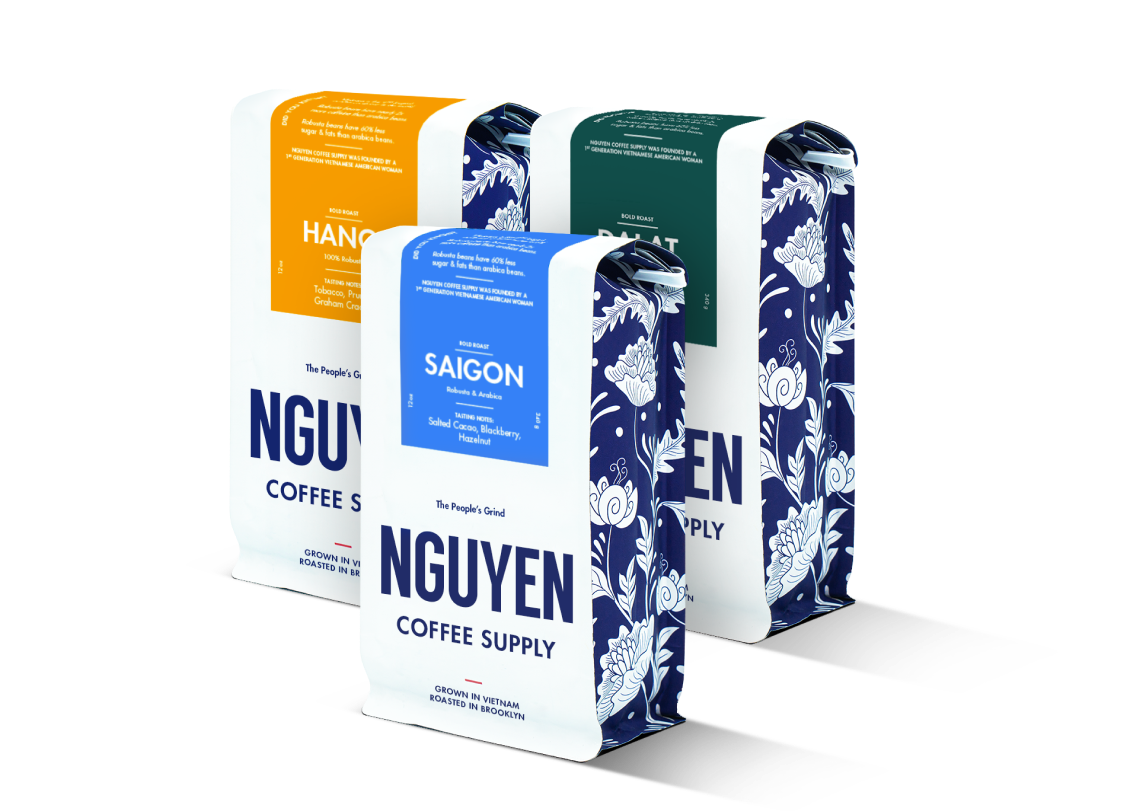

- FEATURED ON IMBIBE

Create for yourself or as a gift for your loved ones
Subscribe nowMe and mom just enjoyed the Nguyen phin drip experience. Wow. Proud of your work. We without hesitation enjoy the Vietnamese coffee and recommend your products. Thank-you to the Nguyen staff and tradition. From Canada eh!
These days, coffee bags you find at stores and cafes may have labels of not only where the coffee beans come from, but also of what type of coffee bean it is. You’ll most commonly see words such as “100% arabica” or other varieties of coffee beans such as excelsior or liberica. In some cases, you might even find a 100% single origin robusta coffee. These are all different species of coffee and being unique from one another, they each have their own distinctive characteristics.
What is the difference between arabica and robusta coffee (the two most commonly produced and consumed species)?

1. Flavor profile– The difference in taste between robusta coffee and arabica coffee is stark. When you taste two specialty varieties of each, you’ll most likely notice that the robusta coffee has a deep, bold flavor with nutty and chocolatey undertones whereas the arabica will likely be bright and citrusy with notes of fruit.
These differences stem from not only the coffee beans being different species, but also from the ways each bean is processed after harvesting (robusta is often natural processed and arabica is often washed). Is arabica coffee better than robusta coffee? Or is robusta coffee better than arabica coffee? Neither! Each species of coffee has its unique characteristics and when produced to be high quality, they can make for exceptional cups of coffee.
2. Caffeine content– Robusta coffee naturally has almost twice the caffeine than arabica coffee. When brewed, this is important to remember as you’ll only need half the amount of coffee you’d normally consume if drinking 100% robusta.
The added benefit to this level of caffeine is that the robusta coffee plant is naturally more pest resistant as caffeine acts as a chemical defense, which also allows farmers to use less or no pesticides in their growing practices.
3. Fats & sugars– Robusta coffee beans similarly have 60% less sugars and fats (lipids) than arabica coffee. While this does not make for significant differences in things like resulting blood sugar levels or calorie content, it does impact the aforementioned flavor profile of each coffee bean. With less fats and sugars, robusta coffee is bold and strong in flavor whereas arabica coffee tends to be milder and sweeter.
4. Antioxidants– Coffee contains a compound called chlorogenic acid among other antioxidants. Just like caffeine, robusta coffee also has more chlorogenic acid than arabica coffee. Some studies suggest that consuming coffee is beneficial for these reasons, which has led some to believe that robusta coffee could potentially be a healthier choice when it comes to coffee variety.
5. Growing conditions– Arabica coffee is a finicky plant. It can generally only grow above elevations of 3,000 feet and in subtropical climates. Additionally, many arabica coffees are grown in the shade. Robusta, however, can grow at a variety of elevations and climates, both subtropical and tropical. Robusta coffee can also thrive in the sun.
Overall, robusta coffee is the hardier plant and can thrive in a variety of conditions. While arabica has historically been the dominant coffee species consumed globally, this may change in the face of climate change and given each coffee bean’s respective growing conditions.
6. Cultivation– Robusta and arabica coffee beans have to be harvested differently. Robusta coffee grows in uniform clusters that ripen simultaneously on the branch. Arabica coffee grows in uneven clusters that ripen at various times. For farmers and producers, this makes robusta the easier and more cost-effective variety of coffee to grow because robusta coffee can be harvested all at once by pulling the entire branch or by using a machine. However, for arabica coffee, farmers need to hand pick each cherry since they ripen at different times and doing so all at once would result in wasted, unripened coffee cherries unfit for processing and consumption.
7. Shape– If you take a look at arabica and robusta coffee beans, you’ll notice that they are actually different in size and shape. Arabica coffee beans are more ovular and long while robusta coffee beans are stouter and circular in shape. Additionally, the split line running down the middle of arabica beans tends to be curved whereas the split in robusta coffee beans appears a bit straighter!
Ultimately, there are more differences between arabica and robusta coffee that didn’t even make it to this list. These are just the main differences! When it comes to which is better or worse, we believe that there is no absolute right or wrong here. Both species of coffee have their unique properties and we love them both. For those who enjoy bold and strong coffee, robusta coffee might be the one. For those who enjoy bright and fruity coffee, arabica coffee may be the best bet. For those looking for a unique experience that combines the two, we recommend our Loyalty blend!
––